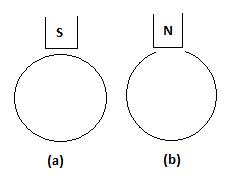Question
Question: In a closed ring (a) and in an open ring (b) magnets are falling along the axis of the ring. The cur...
In a closed ring (a) and in an open ring (b) magnets are falling along the axis of the ring. The current generated in (a) and (b) have which directions if observed from top?

A. Clockwise, anti-clockwise
B. Anti-clockwise, clockwise
C. Clockwise, zero
D. Anti-clockwise, zero
Solution
To answer this question we must have a proper knowledge of Lenz’s law. Lenz’s law states that in a closed surface current is produced. And in the open surface there is no flow of current.
Complete step by step solution:
Lenz's law states that the path of an induced emf would be such that if this were to allow a current to flow through a conductor in an external circuit, then that current will produce a field that will resist the shift that generated it.
A closed surface is a compact, boundless surface. For example, spaces such as the sphere, the torus, and the Klein bottle are closed surfaces. An open layer requires edges and has no width. With this magnetism can be located along the edge of the earth.
According to Lenz's law the current produced in (a) shall grow S pole to oppose the cause generating it. The present is, however, clockwise. The circuit is open in (b) No current will flow.
Hence, option C is correct.
Note: In an open circuit current does not flow. A continuous, unbroken path along which electrons will pass is a closed loop. Charges, or electricity, can only flow through a closed circuit. A split or gap of a circuit produces an open circuit. Charges will not circulate through an open loop.
Basically, current flow implies the amount of electrons charged with regard to time. In an electric circuit, the current can travel in the opposite direction while the electric charge is flowing in one direction.
